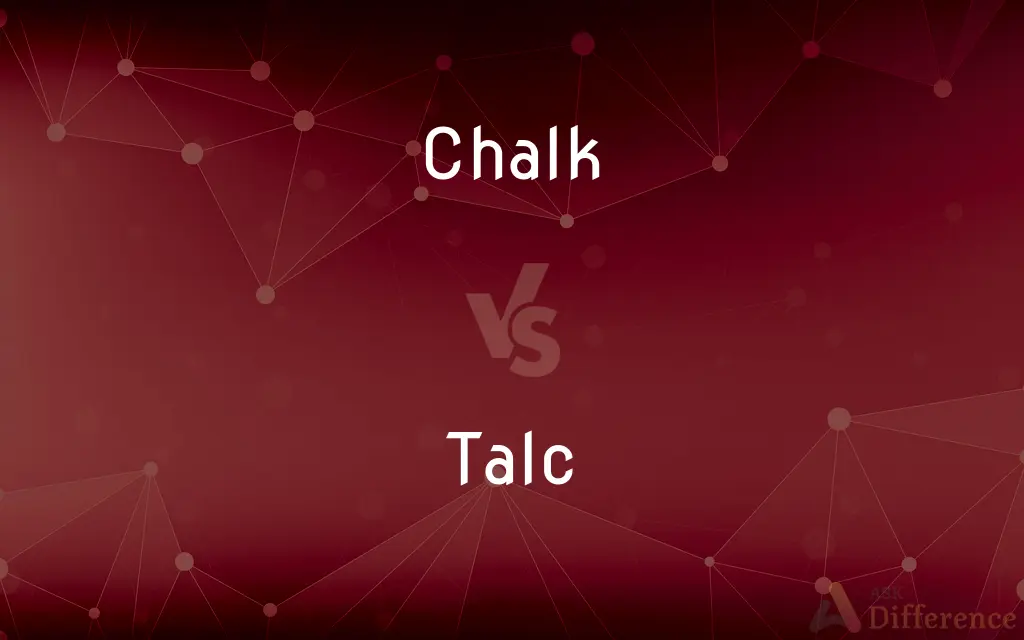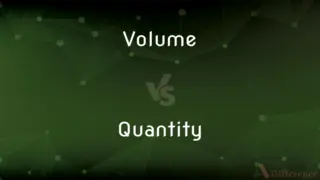Chalk vs. Talc — What's the Difference?
Edited by Tayyaba Rehman — By Urooj Arif — Updated on March 28, 2024
Chalk is a soft, white, porous sedimentary rock, ideal for writing on blackboards, while talc is the softest mineral, used in baby powder and industrial applications.

Difference Between Chalk and Talc
Table of Contents
ADVERTISEMENT
Key Differences
Chalk is primarily composed of calcium carbonate, making it suitable for educational and artistic uses due to its ability to leave marks on surfaces like blackboards and sidewalks. On the other hand, talc, known for its softness on the Mohs scale of mineral hardness, is favored in cosmetic and industrial products for its absorbent and lubricative properties.
Chalk's structure allows it to be easily shaped into sticks for manual handling, making it popular in classrooms and sports fields for line marking. Whereas talc, due to its fine granular form, is often processed into powder, making it ideal for personal hygiene products, like baby powder, to reduce friction and prevent rashes.
The porosity of chalk enables it to produce a matte finish when used in art, providing a unique texture that is difficult to achieve with other materials. Talc, in contrast, can impart a silky or glossy finish to cosmetics, such as face powders and eyeshadows, enhancing the visual appeal of these products.
In terms of environmental impact, chalk production involves minimal processing, often just extraction and shaping, thereby exerting a lower environmental footprint. Talc processing, however, can include significant refining to achieve the desired purity and particle size, which may have a greater environmental impact due to the energy and resources required.
Chalk is readily biodegradable and poses minimal risk to water and soil when used outdoors. Talc, while also a natural mineral, has faced scrutiny for potential health risks when inhaled or used in personal care products, leading to stricter regulations and safety assessments in its application.
ADVERTISEMENT
Comparison Chart
Composition
Calcium carbonate (CaCO3)
Magnesium silicate hydroxide (Mg3Si4O10(OH)2)
Mohs Hardness
1-2
1 (softest mineral)
Primary Use
Writing and drawing on surfaces
Personal care products, industrial applications
Texture
Porous and rough
Smooth and slippery
Environmental Impact
Lower due to minimal processing
Higher due to extensive refining processes
Compare with Definitions
Chalk
A type of limestone used for writing on boards.
The teacher used red chalk to highlight important points.
Talc
Incorporated in cosmetics for a silky finish.
Face powders often contain talc for a smoother appearance.
Chalk
In art, chalk provides a matte finish.
Artists choose chalk for its unique textural qualities.
Talc
A mineral used in baby powder for its smooth texture.
Talcum powder keeps the baby’s skin dry and rash-free.
Chalk
Used in sports for grip.
Gymnasts apply chalk to their hands to prevent slipping.
Talc
Talc is added to paint as a filler to improve its properties.
Talc improves paint coverage and durability.
Chalk
Biodegradable and eco-friendly for outdoor use.
Line markings on sports fields are often made with chalk for easy removal.
Talc
Used as a lubricant in industrial processes.
Talc reduces friction in manufacturing.
Chalk
Crushed chalk is used in agriculture to alter soil pH.
Farmers spread chalk on fields to reduce acidity.
Talc
Involved in health and safety regulations due to inhalation risks.
Talc in cosmetic products undergoes rigorous testing for safety.
Chalk
Chalk is a soft, white, porous, sedimentary carbonate rock, a form of limestone composed of the mineral calcite and originally formed deep under the sea by the compression of microscopic plankton which had fallen to the sea floor. Chalk is common throughout Western Europe, where deposits underlie parts of France, and steep cliffs are often seen where they meet the sea in places such as the Dover cliffs on the Kent coast of the English Channel.
Talc
Talc, or talcum, is a clay mineral, composed of hydrated magnesium silicate with the chemical formula Mg3Si4O10(OH)2. Talc in powdered form, often combined with corn starch, is used as baby powder.
Chalk
A white soft earthy limestone (calcium carbonate) formed from the skeletal remains of sea creatures.
Talc
A fine-grained white, greenish, or gray mineral, Mg3Si4O10(OH)2, having a soft soapy feel and used in talcum and face powder, as a paper coating, and as a filler for paint and plastics.
Chalk
Short for French chalk
Talc
To apply this substance to (a photographic plate, for example).
Chalk
Write or draw with chalk
He chalked a message on the board
Talc
(obsolete) Originally a large range of transparent or glistening foliated minerals. Examples include mica, selenite and the hydrated magnesium silicate that the term talc generally has referred to in modern times (see below). Also an item made of such a mineral and depending for its function on the special nature of the mineral (see next). Mediaeval writers adopted the term from the Arabic.
Chalk
Charge (drinks bought in a pub or bar) to a person's account
He chalked the bill on to the Professor's private account
Talc
(obsolete) A microscope slide made of a plate of mica, generally in use from the start of modern microscopy until the early nineteenth century, after which glass slides became the standard medium.
Chalk
A soft compact calcite, CaCO3, with varying amounts of silica, quartz, feldspar, or other mineral impurities, generally gray-white or yellow-white and derived chiefly from fossil seashells.
Talc
A soft mineral, composed of hydrated magnesium silicate, that has a soapy feel and a greenish, whitish, or grayish color, and usually occurs in foliated masses.
Chalk
A piece of chalk or chalklike substance in crayon form, used for marking on a blackboard or other surface.
Talc
Talcum powder.
Chalk
(Games) A small cube of chalk used in rubbing the tip of a billiard or pool cue to increase its friction with the cue ball.
Talc
(transitive) To apply talc to.
Chalk
A mark made with chalk.
Talc
A soft mineral of a soapy feel and a greenish, whitish, or grayish color, usually occurring in foliated masses. It is hydrous silicate of magnesia. Steatite, or soapstone, is a compact granular variety.
Chalk
Chiefly British A score or tally.
Talc
A fine grained mineral having a soft soapy feel and consisting of hydrated magnesium silicate; used in a variety of products including talcum powder
Chalk
To mark, draw, or write with chalk
Chalked my name on the blackboard.
Talc
Apply talcum powder to (one's body)
Chalk
To rub or cover with chalk, as the tip of a billiard cue.
Chalk
To make pale; whiten.
Chalk
To treat (soil, for example) with chalk.
Chalk
(uncountable) A soft, white, powdery limestone (calcium carbonate, CaCO3).
Chalk cliffs are not recommended for climbing
Chalk
(countable) A piece of chalk, or nowadays processed compressed gypsum (calcium sulfate, CaSO4), that is used for drawing and for writing on a blackboard (chalkboard).
The chalk used to write on the blackboard makes a squeaky sound
Chalk
Tailor's chalk.
Chalk
A white powdery substance used to prevent hands slipping from holds when climbing, or losing grip in weight-lifting or gymnastics, sometimes but not always limestone-chalk, often magnesium carbonate (MgCO3).
When working out your next move, it's a good idea to get some more chalk from the bag
Chalk
A platoon-sized group of airborne soldiers.
Chalk
The favorite in a sporting event.
Chalk
The prediction that there will be no upsets, and the favored competitor will win.
Chalk
To apply chalk to anything, such as the tip of a billiard cue.
Chalk your hands before climbing
Chalk
To record something, as on a blackboard, using chalk.
Chalk
To use powdered chalk to mark the lines on a playing field.
Chalk
(figuratively) To record a score or event, as if on a chalkboard.
Chalk
To manure (land) with chalk.
Chalk
To make white, as if with chalk; to make pale; to bleach.
Chalk
A soft, earthy substance, of a white, grayish, or yellowish white color, consisting of calcium carbonate, and having the same composition as common limestone.
Chalk
Finely prepared chalk, used as a drawing implement; also, by extension, a compound, as of clay and black lead, or the like, used in the same manner. See Crayon.
Chalk
To rub or mark with chalk.
Chalk
To manure with chalk, as land.
Chalk
To make white, as with chalk; to make pale; to bleach.
Let a bleak paleness chalk the door.
Chalk
A soft whitish calcite
Chalk
A pure flat white with little reflectance
Chalk
Amphetamine used in the form of a crystalline hydrochloride; used as a stimulant to the nervous system and as an appetite suppressant
Chalk
A piece of chalk (or similar substance) used for writing on blackboards or other surfaces
Chalk
Write, draw, or trace with chalk
Common Curiosities
Are there any health concerns associated with talc?
Yes, inhaling talc powder can pose health risks, and its use in personal care products is closely regulated.
What is chalk used for?
Chalk is used for writing on blackboards, artistic creations, sports field markings, and adjusting soil pH.
Can chalk and talc be used interchangeably?
No, their different properties and uses generally prevent them from being used interchangeably.
Is chalk environmentally friendly?
Yes, chalk is biodegradable and has a lower environmental impact due to minimal processing.
What makes talc unique?
Talc's softness and ability to absorb moisture make it unique, leading to its use in baby powders, cosmetics, and as an industrial lubricant.
How does chalk affect soil?
Chalk can reduce soil acidity, improving the environment for plant growth.
How is talc processed for use in cosmetics?
Talc is refined to remove impurities and achieve the desired particle size for cosmetic applications.
What industries benefit from talc's lubricative properties?
The automotive, manufacturing, and electronics industries benefit from talc's lubricative properties.
What is the main component of chalk?
Chalk is primarily composed of calcium carbonate.
Why is talc used in baby powder?
Talc is used in baby powder for its ability to absorb moisture and reduce friction, preventing rashes.
How does talc contribute to the cosmetic industry?
Talc provides a silky texture and helps in moisture absorption in cosmetics.
How do chalk and talc differ in texture?
Chalk is porous and rough, ideal for marking, while talc is smooth and slippery, suitable for personal care and industrial applications.
What are the environmental concerns associated with talc?
The extraction and processing of talc can have environmental impacts, including energy consumption and potential contamination.
Is chalk harmful to humans?
Chalk is generally considered safe for use in its intended applications, though ingestion in large quantities can be harmful.
Can talc be found in food products?
Yes, talc can be used as an anti-caking agent in certain food products, subject to regulatory approval.
Share Your Discovery

Previous Comparison
Volume vs. Quantity
Next Comparison
Corvette vs. CutterAuthor Spotlight
Written by
Urooj ArifUrooj is a skilled content writer at Ask Difference, known for her exceptional ability to simplify complex topics into engaging and informative content. With a passion for research and a flair for clear, concise writing, she consistently delivers articles that resonate with our diverse audience.
Edited by
Tayyaba RehmanTayyaba Rehman is a distinguished writer, currently serving as a primary contributor to askdifference.com. As a researcher in semantics and etymology, Tayyaba's passion for the complexity of languages and their distinctions has found a perfect home on the platform. Tayyaba delves into the intricacies of language, distinguishing between commonly confused words and phrases, thereby providing clarity for readers worldwide.
















































